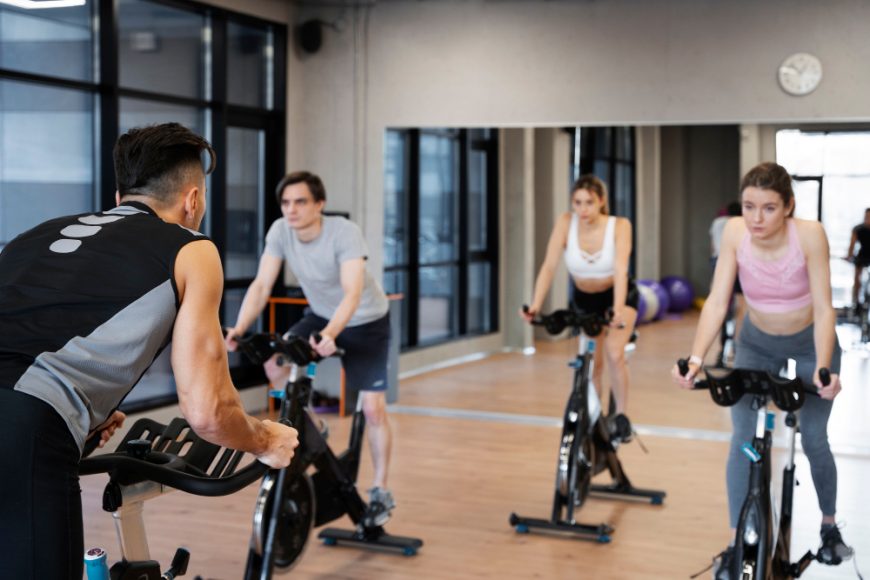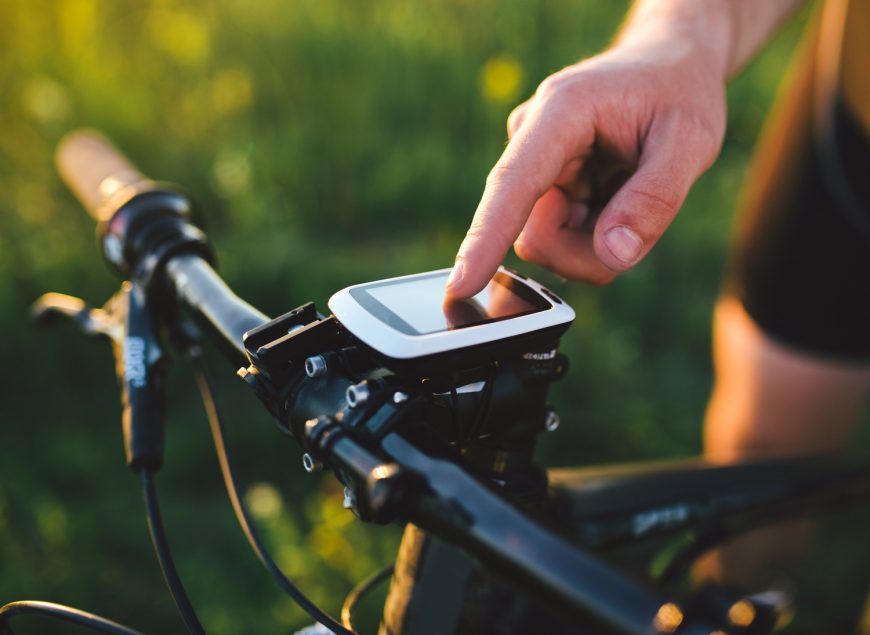Indoor Bike Trainers are even more popular now because they offer an alternative to training regardless of the weather and time. Many pro-cyclists like Mathieu van der Poel, Marianne Vos, and Chris Froome prefer to train on indoor bike trainers. In 2020, researchers at the University of Colorado Boulder conducted a study on The effects of indoor cycling training on cardiovascular fitness and body composition. The study proved that:
Indoor cycling training is an effective way to improve cardiovascular fitness and body composition in healthy adults. Indoor cycling training is also a low-impact exercise, which makes it a good option for people with joint problems
With so many benefits, I am sure we all have, at some point wondered, how we track our indoor bike trainer performance to improve it. But how do we do that? Here’s the good part. With indoor bike trainers, you need a method to track how well you are performing. You can measure the distance that you have cycled.
So how do we measure the distance? You are in for a surprise because I am going to answer precisely that.

Methods To Measure Distance On An Indoor Bike Trainer
Here are some of the methods that you can use to measure distance on an indoor bike trainer, enjoy!
1. Using A Power Meter
If you are using advanced bike trainers, then you are going to love what I am about to tell you. You can use power meters to track the distance that you have covered. Power meters measure the actual power output in watts generated by your pedaling. In 2020, researchers at the University of Colorado Boulder found out that a power meter is the most accurate method for measuring indoor distance.
The most accurate method for measuring indoor cycling distance was to use a power meter. However, the study also found that other methods, such as using a bike trainer’s built-in distance sensor or using a smartphone app, were also relatively accurate
By tracking your power output and time, you can calculate the distance covered. Power-based distance measurements are highly accurate because they consider the intensity of your efforts. However, power meters are expensive, but you can try and find reasonable options in the market.
Looking for an indoor trainer stand? Check out these options.
2. Measuring Distance With A Bike Computer

Let’s start with the most obvious method to measure distance, and that is why we use a bike computer. I mean, we use the bike computer outdoors to calculate our performance, so why not use it indoors? The only difference is that your bike won’t actually be going anywhere, not like when you are having fun outdoors!
You can use any kind of bike computer you have, you can see Garmin, Wahoo, or even Lezyne. I like using products from Garmin. Everyone has their own preferences so I suggest that you go with whatever option you have. Get on the bike trainer and give everything that you can, the computer will then calculate everything for you.
As I said before, using an indoor bike trainer will be different indoors and outdoors. The elevation keeps on changing when you are outdoors and the situation is different when you are indoors.
3. Measuring With Your Average Speed
With the help of your average speed, you can easily track the distance that you have covered. Let’s assume that you have an average speed of around 15mph on flat roads, if you put the same effort into a bike trainer, you can find out the distance that you have traveled. For example, if you ride for 30 minutes on a bike trainer and maintain a speed of 15mph, you would have covered 7 miles.
There is one thing that you need to keep in mind here. The resistance that you set needs to be the same level as outdoors. Apart from the resistance, the cadence and effort also need to remain the same. Once you master this you will be able to track your performance more effectively.
The information that you will calculate won’t be accurate if we compare it directly with a sensor but it will be really close. Do give it a try and let me know about the results.
4. Using Trainer-Specific Distance Calculations
Not all bike trainers are the same, some have unique properties which give them a performance edge. Some trainers come with their own proprietary methods of distance calculation. These methods often take into account resistance settings, power output, and other factors to estimate the distance covered. While they can be convenient, their accuracy may vary between trainer brands and models.
5. GPS-Based Virtual Rides
Let’s talk about GPS-Based Virtual Rides. I’m sure that most of you might not have heard about them, Have you? Some indoor cycling apps, like FulGaz and Kinomap, allow you to ride virtual routes based on GPS data. You can use a GPS-enabled device like a smartphone or a dedicated GPS bike computer to track your distance and progress.
This method is immersive and replicates outdoor rides closely. If you ask me, I love using GPs-based rides, it is so much fun. Apart from fun, these rides allow you to break records set by different riders, providing a new level of immersion.
6. Online Cycling Platforms
Online cycling platforms are great. There are really impressive cycling platforms that you can use like Zwift, RGT, Rouvy, TrainerRoad, and SufferFest. Let me tell you how they work!
Most of these cycling platforms will extract your data from the trainers and convert them into an online gaming experience which can be quite fun!
In order to make things easier for you, I explain how Zwift works, since that’s the most famous cycling platform right now. Zwift will use your cycling data to calculate algorithms of its own, and those algorithms will move your avatar on a bicycle through different tracks, cities, surfaces, and whatnot. One of the best aspects of Zwift is that by using your avatar, you can interact with different riders from across the world. Seems fun right?!
Whatever sensor you have installed on your trainer, Zwift will use it to calculate distance and speed. The combination of a power meter and Zwift is really great, do give it a try.
Check out these cycling apps to find the best options!
7. Time-Based Estimations
What should you do if you have a really old trainer? Well, I have some good news for you! there is nothing wrong with having a simple indoor trainer. In this kind of situation, you can use time-based estimations to calculate the distance that you have covered. Keep in mind that this method is not very accurate but can give you a rough idea of your workout’s duration.
Nothing seems to work. Maybe you are making some of these indoor cycling mistakes.
Pros And Cons Of Measuring Distance On An Indoor Bike Trainer
| Pros | Cons |
|---|---|
| Accurate Tracking | Lack of Real-World Terrain |
| Indoor bike trainers provide precise distance tracking, allowing cyclists to monitor their progress and set specific training goals. | Distance measurements on indoor trainers may not reflect the same conditions and terrain as outdoor rides, leading to a different cycling experience. |
| Controlled Environment | Potential Monotony |
| Indoor trainers offer a controlled environment free from external factors like wind and weather, making it easier to focus on consistent training. | Riding in the same location indoors may become monotonous for some cyclists, lacking the variety and scenery of outdoor routes. |
| Weather Independence. | No Wind or Elevation Changes. |
| Regardless of weather conditions, indoor trainers ensure cyclists can train and measure distance consistently, providing an ideal solution for year-round training. | Unlike outdoor rides, indoor trainers typically lack variations in wind resistance and elevation changes, which may impact the overall riding experience. |
| Virtual Training Options. | Limited Real-World Experience. |
| Many indoor trainers are compatible with virtual training apps and platforms, offering gamified experiences, simulated routes, and competition, enhancing motivation and training variety. | While virtual training can be engaging, it may not fully replicate the real-world conditions and challenges encountered on outdoor rides. |
| Precise Data Analysis. | Indoor vs. Outdoor Discrepancies. |
| Cyclists can analyze detailed data on their performance, including distance, power output, and cadence, leading to more informed training decisions. | Cyclists should be aware of the differences in distance measurements between indoor and outdoor riding, which may affect goal setting and performance evaluation. |
FAQs
How Do You Track Distance On A Stationary Bike?
It isn’t that hard to track the distance covered on a stationary bike, you just need to have the proper tools for that. You can use wearable fitness trackers to calculate the distance covered, try going for Garmin or Wahoo devices.
Can You Use Stationary Indoor Trainers Everyday?
According to experts, you should use an indoor trainer 4-6 days a week. It is imperative that you take one or two rest days weekly, doing so will give you better results.
Can You Measure The Distance Traveled Using an Apple Watch?
You cannot use an Apple Watch to measure the distance traveled. With that being said, the watch is fitted with sensors to measure metrics such as heart rate and the time that you have spent on an indoor trainer.
How Far Can You Go On A Stationary Bike In 30 Minutes?
Although this depends on your riding efficiency, you can easily cover about 3-3.5 miles in 30 minutes.
How Accurate Are Online Cycling Platforms?
Cycling platforms cannot mimic the actual road conditions, distance, and speed of the real cycling experience but they come pretty close. Their accuracy is amazing actually, they can easily calculate how much distance you have covered and the speed you have maintained on an indoor bike trainer.
Are Online Cycling Platforms Helpful For Tracking Progress?
Cycling platforms help you a lot when it comes to improving cycling performance. You can track how much distance you have covered and the speed you have maintained and then strive to be better in the next session. You will be given a thorough and detailed breakdown of your endeavors!
Looking for an indoor trainer? Here’s where you can find some most high-rated options!
Recap
Tracking your progress and measuring the distance that you have covered on an indoor bike trainer can be really easy. All you just need to have the proper tools/setup for that. There are several methods to accurately gauge your progress and push your limits, from basic speed and time calculations to advanced technologies like smart trainers and virtual cycling platforms, the most accurate one is using a power meter!
However, the method that suits you the most depends on your budget and preference. Whatever method you choose the ability to measure distance on your trainer opens up a world of opportunities. Embrace the challenge and be better!
Also Read:
Should you have any questions or require further clarification on the topic, please feel free to connect with our expert author Rhodes Perry by leaving a comment below. We value your engagement and are here to assist you.

